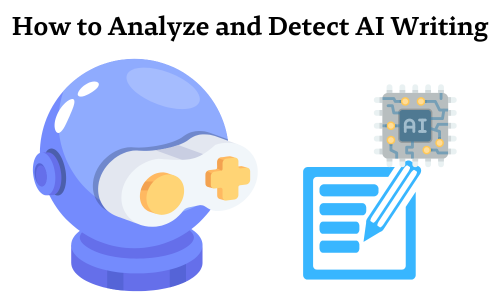Artificial intelligence (AI) has made significant advancements in various fields, and one area where it has gained considerable attention is in writing. AI-powered language models can generate human-like text, which raises the question of how to detect AI writing. With the increasing sophistication of AI language models, it has become crucial to develop techniques that can accurately differentiate between AI-generated content and text written by humans. Detecting AI writing is essential to maintain transparency, authenticity, and trust in various domains, including journalism, academia, and online platforms.
Table of Contents
Part 1: Characteristics of AI Writing
Part 2: How to Analyze and Detect AI Writing
Part 3: Implications and Challenges
Part 1. Characteristics of AI Writing
Language models like OpenAI's GPT-3 have been trained on vast amounts of data to mimic human writing styles and produce coherent and contextually relevant content. However, despite their impressive abilities, AI-generated text often exhibits certain distinct characteristics that can be used for identification. To detect AI writing, it is essential to examine the following characteristics:
Sentence Structure
AI-generated content may display impeccable grammar and syntax, but it can sometimes lack the natural variations and occasional errors that humans make. AI models tend to produce structurally consistent sentences without the occasional slips that humans might make.
Vocabulary and Phrasing
AI language models have an extensive vocabulary and can use sophisticated language. However, they may occasionally misuse or overuse certain words, resulting in a lack of diversity or inappropriate word choices.
Contextual Coherence
AI writing might struggle with maintaining contextual coherence throughout a piece of text. While it can generate individual sentences that make sense, the overall flow and logical progression of ideas may not be as smooth as in human writing.
Part 2. How to Analyze and Detect AI Writing

2.1 Linguistic Analysis
Linguistic analysis can be an effective method for detecting AI writing. By examining various linguistic aspects, we can uncover patterns that indicate the involvement of AI in the text generation process.
2.2 Sentence Structure
AI-generated text often exhibits consistent sentence structures and lengths. Human-written content, on the other hand, may have more variations and occasional sentence fragments or run-on sentences.
2.3 Vocabulary and Phrasing
Analyzing the vocabulary and phrasing can help identify AI-generated text. AI models might rely on certain phrases or expressions that are less common in human writing, or they may lack the subtleties and nuances that humans incorporate into their language.
2.4 Contextual Coherence
Evaluating the overall coherence and logical flow of the text can reveal whether it is AI-generated or human-written. AI models can struggle with maintaining a coherent narrative, leading to abrupt transitions or disjointed paragraphs.
2.5 Style and Tone
Style and tone analysis can provide valuable insights into the origin of the text. AI-generated content may lack a personal touch or a distinct writing style, whereas human writing often reflects the author's personality and individuality.
2.6 Deep Learning Markers
AI-generated text leaves subtle markers that can be identified through deep learning techniques. These markers include statistical patterns, word frequency distributions, and syntactic structures that differ from those found in human writing.
2.7 Metadata Analysis
Examining metadata associated with the text can offer clues about its source. For example, timestamps, author profiles, or platform-specific information can help determine whether the content was likely generated by AI.
2.8 Human Evaluation
Human evaluation plays a crucial role in distinguishing AI writing from human writing. Trained experts can assess various aspects such as style, coherence, and overall quality to determine the likelihood of AI involvement.
2.9 Tools and Technologies
Advancements in AI detection tools and technologies have made it easier to identify AI-generated content. These tools employ machine learning algorithms and statistical models to analyze text and detect patterns that indicate AI involvement.
Part 3. Implications and Challenges
Detecting AI writing has important implications for maintaining transparency and trust in various domains. However, it also poses challenges as AI models become increasingly sophisticated and capable of mimicking human writing styles. Continuous research and development of detection techniques are necessary to stay ahead of evolving AI technologies.
FAQs: More About Detecting AI Writing
1. Can AI-generated text be mistaken for human writing?
Yes, AI-generated text can often mimic human writing to a high degree, making it challenging to differentiate between the two. However, careful analysis and evaluation can help identify subtle differences.
2. Are there any foolproof methods for detecting AI writing?
No, there is no foolproof method for detecting AI writing, as AI models are constantly improving. It requires a combination of techniques, including linguistic analysis, style evaluation, and human judgment.
3. Can AI detection tools keep up with evolving AI models?
AI detection tools are continuously being developed and updated to keep up with advancements in AI models. However, there will always be a race between detection methods and AI capabilities.
4. What are the potential applications of AI detection techniques?
AI detection techniques have applications in journalism, academia, content moderation, plagiarism detection, and maintaining trust on online platforms.
5. How can individuals protect themselves from AI-generated misinformation?
Individuals should be critical consumers of online content, fact-check information from reliable sources, and be aware of the possibility of AI-generated text. Relying on trusted platforms and independent verification can help mitigate the risks.
Conclusion
Detecting AI writing is a crucial task in today's digital landscape. By analyzing linguistic characteristics, style and tone, deep learning markers, metadata, and employing human evaluation, it becomes possible to identify AI-generated text. As AI continues to advance, staying vigilant and employing effective detection methods will help ensure the authenticity and integrity of written content.
In conclusion, detecting AI writing is a complex but necessary task in today's AI-driven world. By employing various techniques, including linguistic analysis, style evaluation, and human judgment, we can differentiate between AI-generated content and human-written text. Continuous research and development in this field will be essential to stay ahead of the ever-advancing capabilities of AI.







